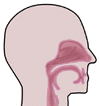


 Dr.
Henkin's research is varied but focused. He initially set out to unravel
the mysteries surrounding diminished, lost, or aberrant abilities to taste
and to smell and as a result he has led the work to many of the discoveries
resulting in treatment for these problems. Dr. Henkin and his associates
have authored more than three hundred medical papers on subjects related
to taste and smell in his 40-year career.
Dr.
Henkin's research is varied but focused. He initially set out to unravel
the mysteries surrounding diminished, lost, or aberrant abilities to taste
and to smell and as a result he has led the work to many of the discoveries
resulting in treatment for these problems. Dr. Henkin and his associates
have authored more than three hundred medical papers on subjects related
to taste and smell in his 40-year career.
Several innovative studies were performed recently which demonstrate how the smell function can be measured and quantified. Summaries of two such studies are available below.
His work has been published in most major scientific journals including:
New England Journal of Medicine, Science, Nature, Journal of the American Medical Association, American Journal of Medicine, Annals of Internal Medicine, Lancet, Neurology, Endocrinology, Journal of Clinical Endocrinology and Metabolism, Life Science, Journal of Biological Chemistry, Biochimica Biophysica Acta, Biochemical Biophysical Research Communications
Dr. Henkin has written and contributed to many textbooks and books dealing with taste and smell including:
Zinc, published by the National Academy Science, Handbook of Physiology, published by the American Physiology Society, Otolaryngology, published by Lippincott, Difficult Diagnosis, published by Saunders, Pharmacology in Medicine, published by S P Press
Dr. Henkin's work extends to both research and clinical aspects of taste and smell. Initially his research covered descriptions of taste and smell dysfunction in many diseases. Some of these are:
- Henkin, R.I.,
Powell, G.P. Increased taste and smell sensitivity in cystic fibrosis.
Science. 138: 1107-1108, 1962.
- Henkin, R.I., Sensory
mechanisms in familial dysautonomia, in Symposium on Oral Sensation
and Perception, (Bosma, J.F., Ed.), Springfield, IL, C.C., Thomas, 1967,
pp.182-187.
- Henkin, R.I. Abnormalities
of taste and olfaction in patients with chromatin negative gonadal dysgenesis.
J. Clin. Endo. Metab. 27: 1436-1440, 1967.
- Henkin, R.I., Hoye,
R.C., Ketcham, A., Gould, W.J. Hyposmia following laryngectomy. Lancet
II: 479-487, 1968.
- Henkin, R.I., Larson,
A.L., Powell R.D. Hypogeusia, dysgeusia. hyposmia and dysosmia following
influenza-like infection. Ann. Otol. Rhin. Laryngol. 84: 672-682, 1975.
- McConnell, R.J.,
Menedez, C.W., Smith, F.R., Henkin, R.I., Rivlin, R.S. Defects of taste
and smell in patients with hypothyroidism. Amer. J. Med. 59: 354-364,
1975.
- Henkin, R.I., Patten,
B.M., Re, P. Bronzert, D. A syndrome of acute zinc loss. Arch. Neurol.
32: 745-751, 1975.
- Delaney, P., Henkin,
R.I., Slattery, R.A., Manz, H., Bauer, H. Olfactory sarcoidosis: report
of five cases and review of the literature. Arch. Otolaryngol. 103:
717-725, 1977.
- Henkin, R.I. Human
taste and smell disorders, in Encyclopedia of Neuroscience, 2nd Ed.,
(Adelman, G. Ed.), Birkhauser, Boston, 1999, pp. 2010-2013.
- Henkin, R.I. Olfactory dysfunction in Alzheimer's disease. Lancet. 355:1014-1015, 2000.
As more was learned about the basic mechanisms of how taste and smell was influenced by pathology his clinical research was directed toward defining those physiological and molecular mechanisms responsible for development of these disorders. Some of these studies are:
- Henkin, R.I.,
Graziadei, P.P.G., Bradley, D.F. The molecular basis of taste and its
disorders. Ann. Int. Med. 71: 791-821, 1969.
- Henkin, R.I., Lippoldt,
R.E., Bilstad, J., Edelhoch, H. A zinc protein isolated from human parotid
saliva. Proc. Nat. Acad. Sci. USA. 72: 488-492, 1975.
- Henkin, R.I. The role of adrenal corticosteroids in sensory processes, in Adrenal Gland, (Blaschko, H., Sayers, G., Smith, A.D. Eds.), Handbook of Physiology. Endocrinology, Washington, DC. Amer. Physiol. Soc., Sect. 7, Vol. VI, 1975, pp.209-230.
With further study it became clear that growth factors in saliva and nasal mucus influenced stem cell development in both taste and smell systems. Dr. Henkin discovered, isolated, and sequenced growth factors responsible for development and maintenance of stem cells in the taste and smell systems and, thereby responsible for taste and smell function since these stem cells were the progenitor cells for all taste bud and olfactory epithelial cell anatomy, respectively. He discovered that the parotid glands in the mouth and the nasal serous glands in the nose secrete these growth factors into saliva and nasal mucus, respectively. These growth factors act on stem cells in the taste and smell systems through paracrine effects similar in some ways that hormones secreted from various glands in the body into blood influence metabolism through endocrine effects. Some of these studies are:
- Thatcher, B.J.,
Doherty, A.E., Orvisky, E, Martin, B.M., Henkin, R.I. Gustin from human
parotid saliva is carbonic anhydrase VI. Biochem. Biophys. Res. Comm.
250:635-641, 1998.
- Henkin, R.I., Martin,
B.M., Agarwal, R.P. Decreased parotid saliva gustin/carbonic anhydrase
VI secretion: an enzyme disorder manifested by gustatory and olfactory
dysfunction. Amer. J. Med. Sci. 318; 380-391,1999.
- Henkin, R.I., Martin, B.M., Agarwal, R.P. Efficacy of exogenous zinc in treatment of patients with carbonic anhydrase VI deficiency. Amer. J. Med. Sci., 318: 392-404,1999.
Because saliva and nasal mucus are carriers of growth factors necessary to maintain function stem cells of the taste and smell systems, his work extended into study of the physiology, biochemistry and molecular biology of both saliva and nasal mucus. Some of these studies are:
- Henkin, R.I.,
Lippoldt, R.E., Bilstad, J., Wolf, R.O., Lum, C.K.L., Edelhoch, H. Fractionation
of human parotid saliva. J. Biol. Chem. 253: 7556-7565, 1978.
- Agarwal, R.P.,
Henkin, R.I. RIA of human salivary amylase: cross-reactivity with human
and porcine pancreatic amylase and other salivary proteins. Metabolism.
33: 797-807, 1984.
- Agarwal, R.P.,
Henkin, R.I. Metal binding characteristics of human salivary and porcine
pancreatic amylase. J. Biol. Chem. 262: 2568-2575, 1987.
- Henkin, R.I., Doherty, A.E., Martin, B.M. Nasal seroproteins: a new frontier in the exploration of physiology and pathology of nasal and sinus disease. New Frontiers in Immunobiology, (Veldman, JE, Passali, D, Lim, DJ, eds), Kugler, The Hague, 2000, pp.127-152.
Dr. Henkin's work in neurology and neuroradiology opened new vistas into evaluation and treatment of patients with taste and smell dysfunction. Some of these studies are:
- Schechter, P.J.,
Henkin, R.I. Abnormalities of taste and smell following head trauma.
J. Neurol. Neurosurg. Psychiat. 37: 802-810, 1974.
- Levy, L.M., Bartsch,
A.J., Rajan, S., Schellinger, D, Henkin, R.I. MRI of olfactory structures:
normal subjects and patients with olfactory dysfunction. Neuroradiology.
37: 25-26, Suppl.1995.
- Levy, L.M., Henkin,
R.I., Hutter, A, Lin, C.S., Martins, D, Schellinger, D. Functional MRI
of human olfaction. J. Comp. Asst. Tomog. 21:849-856, 1997.
- Levy, L.M., Henkin,
R.I., Hutter, A, Lin, C.S., Schellinger, D. Mapping brain activation
to odorants in patients with smell loss by functional MRI. J. Comp.
Asst. Tomog. 22:96-103, 1998.
- Levy, L.M., Henkin, R.I., Hutter, A, Lin, C.S., Schellinger, D. Increased brain activation in response to odors in patients with hyposmia after theophylline treatment demonstrated by fMRI. J. Comp. Asst. Tomog. 22:760-770, 1998.
Dr. Henkin has also opened new vistas into the evaluation and treatment of patients with distortions of taste and smell and with oral burning. Some of these are:
- Henkin, R.I., Levy,
L.M., Lin, C.S. Taste and smell phantoms revealed by functional magnetic
resonance imaging (fMRI). J. Comp. Asst. Tomog. 24:106-123, 2000.
- Levy, L.M., Henkin,
R.I. Physiologically initiated and inhibited phantosmia:cyclic, unirhinal,
episodic, recurrent phantosmia revealed by brain fMRI. J. Comp. Asst.
Tomog. 24:501-520, 2000.
- Henkin, R.I. Evaluation and treatment of human olfactory dysfunction, in Otolaryngology (English, G.M. Ed.), Lippincott, Philadelphia, 1993, Vol.2, pp.1-86.
For abstracts and photos of a few of these papers please click on the links
Mapping Brain Activity of Normal Subjects
Mapping Brain Activity of Patients with Smell Dysfunction
If you wish to view any of these documents you may write to Dr. Henkin for reprints or you may interact with Medline or Grateful Med on the internet or you may contact your local medical library.
Home
| The Clinic | Diagnosis
| Treatment | FAQ
| Press
Research
| Clinical Overview
| What's New | Contact
Us
The descriptions
on this site are for informational purposes only and are not intended to substitute
for professional medical diagnosis and/or treatment.
If you have further questions, please contact the Taste
and Smell Clinic directly.
All material at this domain copyright © 2000-2022 the Taste and Smell Clinic.